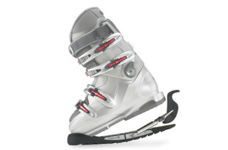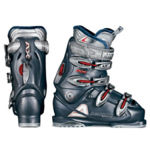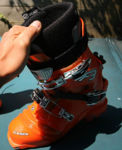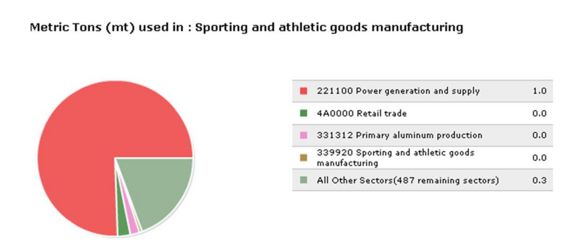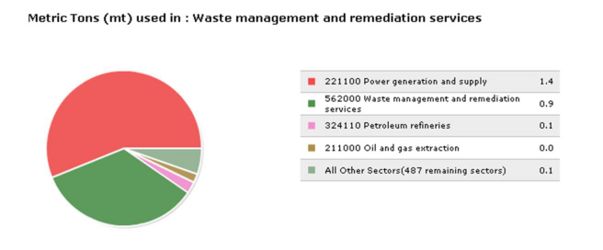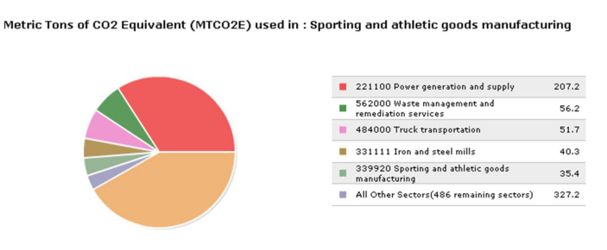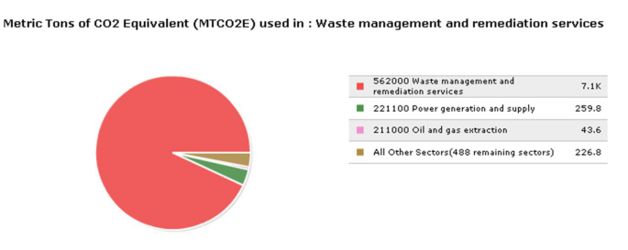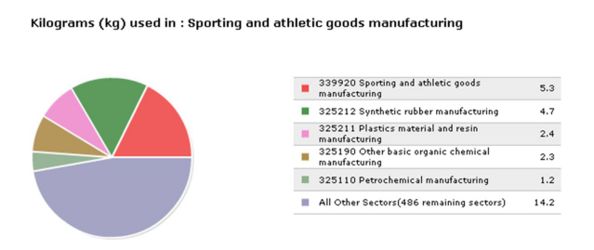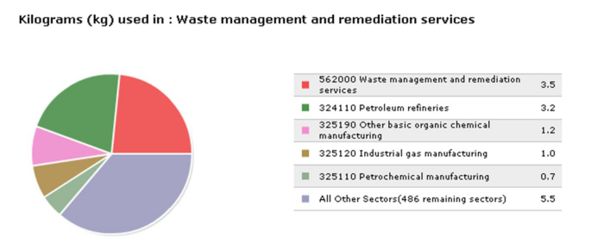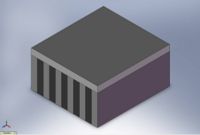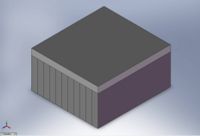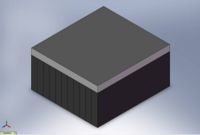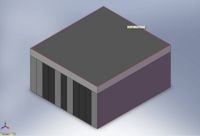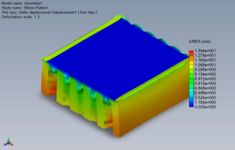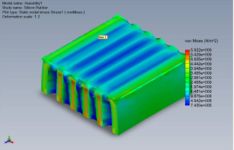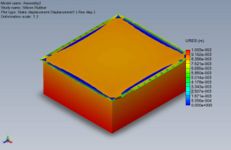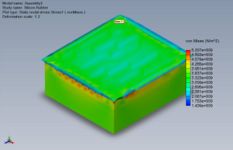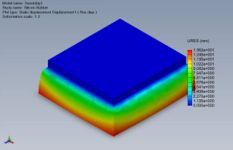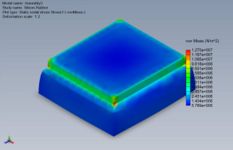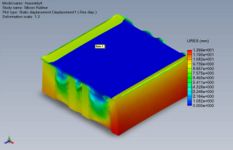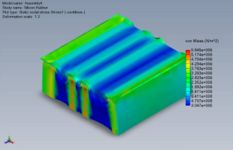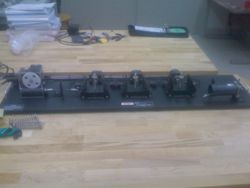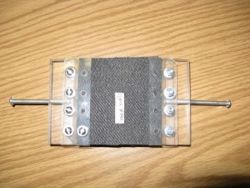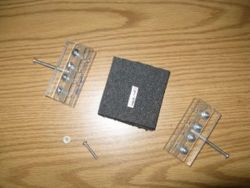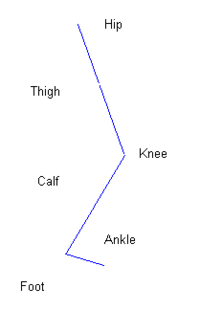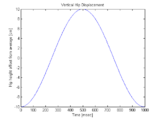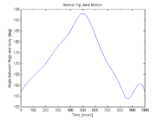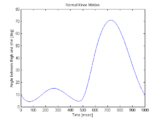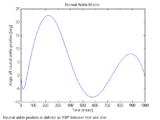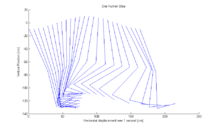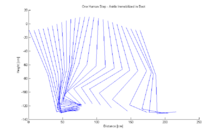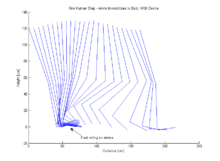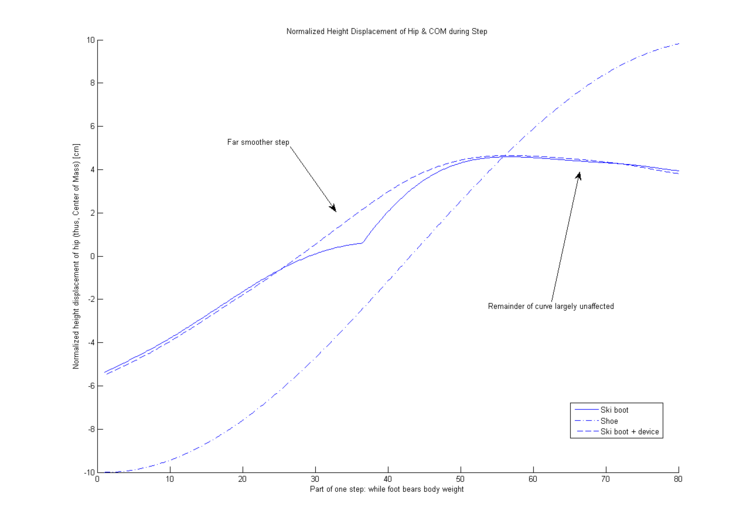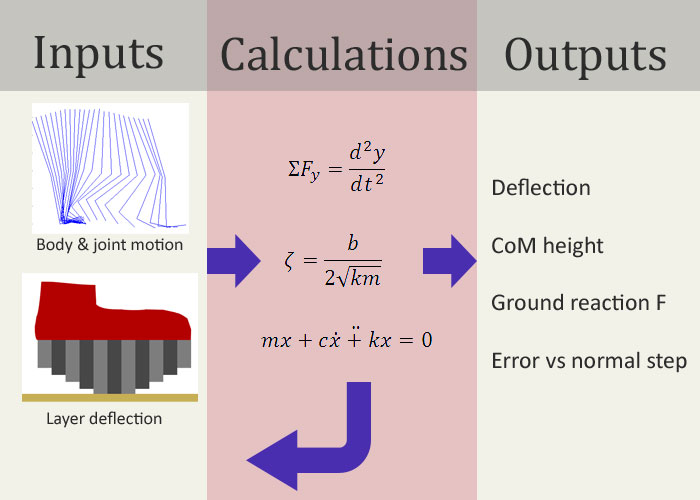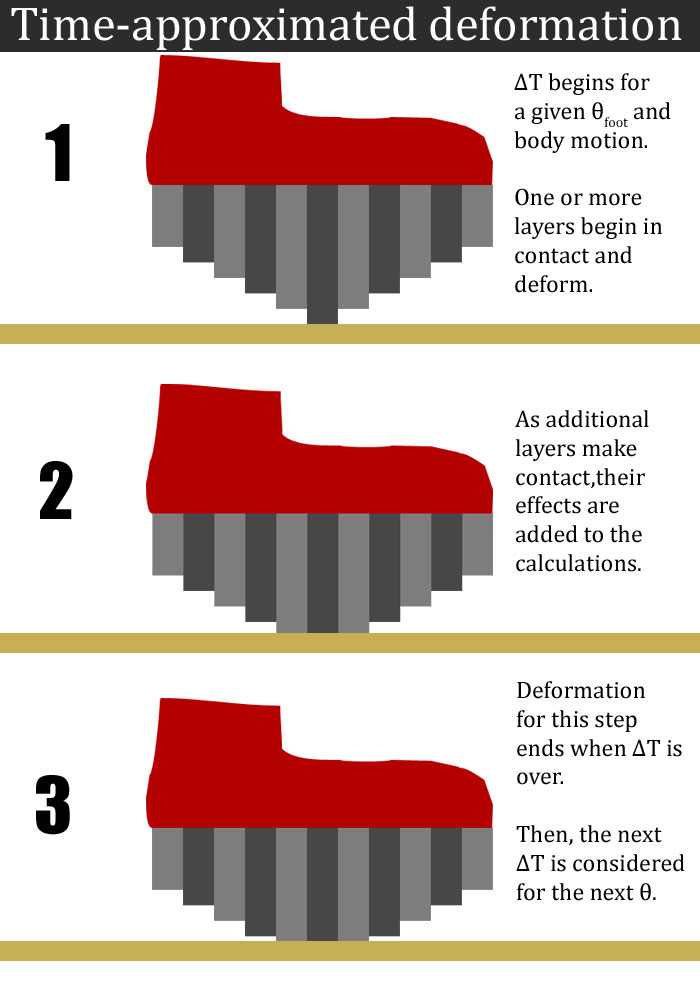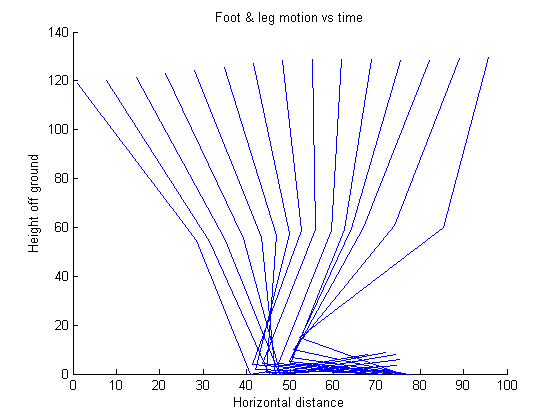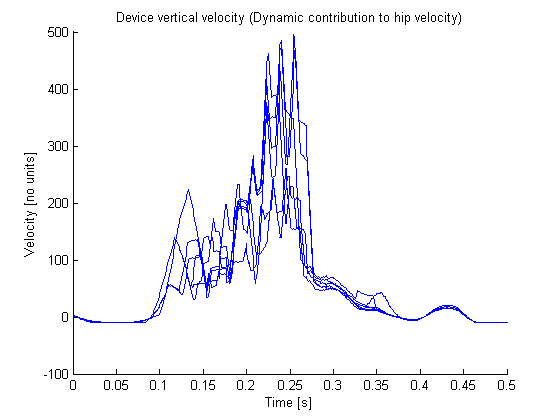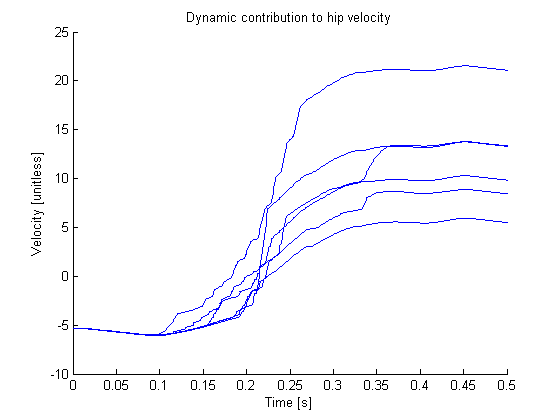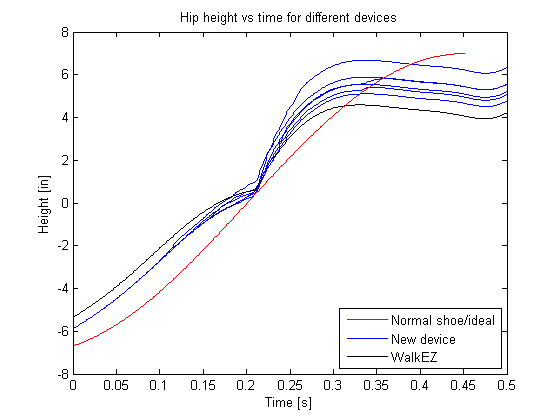Ski boot walking attachment
From DDL Wiki
(→Mechanical Analysis) |
(→Determination of Spring Constants and Damping Coefficients) |
||
| Line 467: | Line 467: | ||
[[Image:SkiBoot_RectilinearSetup.JPG|thumb|right|250px|Rectilinear system used to test material properties.]][[Image:SkiBoot_MaterialMount.jpg|thumb|right|250px|Mount with material inside.]][[Image:SKiBoot_MaterialMount2.jpg|thumb|right|250px|Mount and material taken apart with screw used to put material in mount.]] | [[Image:SkiBoot_RectilinearSetup.JPG|thumb|right|250px|Rectilinear system used to test material properties.]][[Image:SkiBoot_MaterialMount.jpg|thumb|right|250px|Mount with material inside.]][[Image:SKiBoot_MaterialMount2.jpg|thumb|right|250px|Mount and material taken apart with screw used to put material in mount.]] | ||
| - | The goal of this analysis | + | The goal of this analysis was to obtain reasonably accurate spring constant and damping coefficient of each of the rubber materials being used for construction of the walking attachment. These experiments are essential for optimization of the walking attachment design since they would provide us with quantitative measures of the material properties as opposed to vague ideas of how well the materials act as springs and dampers. In addition, the material properties obtained in this experiment are crucial for beam model and MATLAB analyses in order for them to be more intuitive. Especially important is providing the MATLAB model with accurate data would help determine the optimal compositions of rubber and foam (neoprene, silicone, or natural rubber). |
===Overview of Method=== | ===Overview of Method=== | ||
| - | In order to obtain the spring constant and damping coefficient of each material, the rectilinear experimental apparatus for the Mechanical Systems Experimentation (MSE) lab (24452) | + | In order to obtain the spring constant and damping coefficient of each material, the rectilinear experimental apparatus for the Mechanical Systems Experimentation (MSE) lab (24452) was used. This apparatus, as displayed in the first thumbnail on the right, consists of a motor, three carts, vertical supports, and three encoders. The motor applies inputs specified by the experimenters, the encoders measure the displacements, velocity, and acceleration of each cart. The carts can be connected to the vertical supports by springs or in this case, various rubber and foam samples. In order to determine the spring constant and damping coefficient, initial displacement from the equillibrium position can be applied manually, and the carts' response will be monitored. Using MATLAB code developed for the MSE labs, the logarithmic decrement method calculated the spring constants and damping coefficients. |
With logarithmic decrement, the damping ratio is obtained with the following formula, where n = number of peaks used, x<sub>1</sub> = the displacement on the first peak, x<sub>n</sub> = displacement on the ''n''th peak, and zeta = damping ratio. | With logarithmic decrement, the damping ratio is obtained with the following formula, where n = number of peaks used, x<sub>1</sub> = the displacement on the first peak, x<sub>n</sub> = displacement on the ''n''th peak, and zeta = damping ratio. | ||
| Line 485: | Line 485: | ||
[[Image:SkiBoot_DampingRatio.jpg|center]] | [[Image:SkiBoot_DampingRatio.jpg|center]] | ||
| - | In addition to the initial displacement tests, applying a ramp input and dividing the input force by the displacement response over the course of the run could yield another measure for the material properties. With results from the two tests, | + | In addition to the initial displacement tests, applying a ramp input and dividing the input force by the displacement response over the course of the run could yield another measure for the material properties. With results from the two tests, reasonably accurate values of the spring constant and the damping coefficient can be obtained. |
In order to attach the materials to the rectilinear apparatus, we had to specially design brackets to hold the materials and clamp on to the provided posts and carts. To do this, we used the system pictured in the bottom two thumbnails on the right. In the first picture, you can see the completed bracket with the material already screwed inside. The material is placed in the clamp-like area between the two pieces of acrylic. We then run screws through the acrylic, through the material, and out the other piece of acrylic to create a tight hold on the material. One piece of the acrylic is then attached to the stationary post on the rectilinear setup using the large screw sticking out of the back. The other piece of acrylic is mounted to the cart using the large screw. Since we couldn't find properly sized screws, we have implemented a couple nuts to hold the screw in the proper position. | In order to attach the materials to the rectilinear apparatus, we had to specially design brackets to hold the materials and clamp on to the provided posts and carts. To do this, we used the system pictured in the bottom two thumbnails on the right. In the first picture, you can see the completed bracket with the material already screwed inside. The material is placed in the clamp-like area between the two pieces of acrylic. We then run screws through the acrylic, through the material, and out the other piece of acrylic to create a tight hold on the material. One piece of the acrylic is then attached to the stationary post on the rectilinear setup using the large screw sticking out of the back. The other piece of acrylic is mounted to the cart using the large screw. Since we couldn't find properly sized screws, we have implemented a couple nuts to hold the screw in the proper position. | ||
| Line 497: | Line 497: | ||
===Conclusions=== | ===Conclusions=== | ||
| - | + | One of the first tests we performed was that for testing spring linearity. We tested a couple of the materials by applying a ramped force. Since the response seemed to be following a linear path, we can assume that the materials behave like a linear spring. | |
| + | |||
| + | After performing all of the tests, we obtained the following material properties, summarized in the chart below. | ||
| + | {| class="wikitable" border="1" | ||
| + | |- align="center" | ||
| + | ! Material !! Spring Constant (N/m) !! Damping Coefficient (Ns/m) | ||
| + | |- | ||
| + | | Hard Neoprene Rubber | 53681.6 | 50.5793 | ||
| + | |- | ||
| + | | Silicon | 8301.6 | 23.7874 | ||
| + | |- | ||
| + | | Medium Neoprene Foam | 22320.8 | 28.6814 | ||
| + | |- | ||
| + | | Soft Natural Foam | 13754.8 | 24.1424 | ||
| + | |- | ||
| + | | Medium Natural Foam | 10692.1 | 14.5878 | ||
| + | |- | ||
| + | | Soft Neoprene Rubber | 28907.8 | 66.9834 | ||
| + | |} | ||
==MATLAB Model== | ==MATLAB Model== | ||
Revision as of 20:18, 9 December 2008
Contents
|
Executive Summary
Market Research
Fourteen skiers were approached during the market research. Of the group, eight were recreational skiers and six were members of the Carnegie Mellon Ski Team. We asked them for their opinions on walking in ski boots and where they wanted to see improvements. If they were aware of any existing solutions, we requested additional opinions on those solutions. Since most of the skiers that were approached had never heard of the Walk-EZ Revolutions, we had the skiers try them on. With minor adjustments, they were all able to fit into the walking attachment. Afterward, they gave us their feedback.
Survey
There was a general agreement that walking in ski boots is uncomfortable. Most of the recreational skiers wanted to see more flexibility in the boots, specifically around the ankles. Some of their responses were:
- “I just want to be able to bend at the ankles to get more mobility”
- “... the main issue is the flexibility of the foot. I don’t know if this would be possible, but maybe some mechanisms that allow the sole to bend for walking so you can bend your toes a bit.”
- “I would increase flexibility in the leg.”
Several of the serious skiers didn’t want any change on the boots that compromises the structural integrity of the boots and thus reducing the performance. By providing more flexibility to the boots, this provides less support for the ankles and thus jeopardizes the safety of the skier, especially when racing or moving quickly. Listed below were some experts' views on increasing the flexibility of the ski boot:
- “In my experience, there's not much you can do about it…there's always a trade off between comfort and performance.”
- “The other option is something like Tele-boots, which would have the movable toe built-in. I worry about a solution like that compromising boot response and stiffness though when in a binding along with insulation/leakage at the joint.”
- “I'd rather have a good experience skiing than a good experience walking around.”
The skiers agreed on the need of more flexibility around the ankles area when walking in ski boots, especially when walking up and down the stairs, but maintaining the rigidity to provide the support when skiing.
Existing Solutions
Several attempts at solving this problem have been made in the past. All of them have been unsatisfactory or have created more problems than they solve. The three most common solutions to this issue are unbuckling the clips on the boots, ski-walk adjustment, and the Walk-EZ Revolutions walking attachments.
Products
Ankle-Unlock Lever
This adjustment allows the boot's upper cuff to hinge backward. This will give the skier the room needed for a more natural walking motion. Although this is a useful feature, most skiers would choose a more solid rear support in favor of walking comfort. Higher end boots will not have this feature for the reason that ski boots are not built to flex backward because the mechanism often causes the ski boot to lack a rearward support<ref>"Ski-Walk Adjustment." All-Mountain Skier. 2002. <http://books.google.com/books?pg=PA95&lpg=PA95&dq=ski+walk+adjustment&sig=429J6lcY8IXglXzEnxufU37W_f0&ct=result&id=U_w8rVNwCREC&ots=m4OD4WcT1B#PPA95,M1></ref>. All of the people who have tried this feature agree that this mechanism doesn't really work, as a few skiers claimed, "The lock/unlock mechanism doesn't really make very much of a difference because it doesn't provide a very significant degree of freedom" and "I always thought locking-unlocking things don't really improve anything." It provides inconsequential degree of freedom for walking, but the smallest change in the mobility of the boot while skiing dramatically affects the way one skis.
Walk-EZ Revolutions Walking Attachment
These are clip-on attachments for the soles of ski boots that provide a safe, gripping surface and have a curved form which allows a skier to walk more naturally. The addition of a simple, subtle curve to the bottom of the Walk-EZ allows the wearer to walk around in a natural, relaxed posture - eliminating the 15-degree angle/cant automatically imposed on your spine when in ski boots<ref>"Walk-EZ Revolutions" More Inspiration.<http://findarticles.com/p/articles/mi_qa3675/is_200705/ai_n19430501/pg_5></ref>. In addition, an ingenious double hinge allows the units to fold flat for easy storage when not attached to the bottom of the boot. Even though, this device transforms into something more compact, skiers would still rather deal with the discomfort of walking in ski boots than carrying two more things, as some skiers said, "I would love to use something like walk-ez, but I would hate to carry them while not in use, especially when you consider that you ski for several hours (in my case around 5 to 7 hours a day) and you walk for just 15-30 minutes a day" and "The down-side to this is that you have to put them on/take them off to walk in them. What if there were some kind of integrated flip-down version of this that stows away on the back of your boot or something. Might be a good start rather than lugging around extra gear in your camel-back." This was perhaps the best attempt in trying to solve the crisis in walking in ski boots.
Improvisations
Unbuckling the Boots
One way to walk easier in ski boots is to unbuckle the clips that fasten a skier’s foot to the boot. By unbuckling these clips, it allows a greater degree of freedom for the skier’s ankle to rotate because the shin is not held against the stiff outer shell that typically provides the support for the ankle. This outer shell protects the ankles and feet from injury while skiing but presents mostly comfort issues while walking. This practice however, becomes a hassle for inexperienced or young skiers. They would unlatch the clips to walk, and whenever they want to go back on the slopes, they would require assistance in buckling their boots back on. Although some people don't mind the hassle of unbuckling and buckling the clips, like one skier mentioned, "I find unbuckling the boots to work just fine and don't mind doing the John Wayne walk", generally speaking, this is a very inefficient way to acquire some comfort for just a simple task as walking.
Taking the Boots Off and Changing into Regular Shoes
The last existing solution to the discomfort of walking in ski boots is to simply take off the boots, store them somewhere relatively safe from being stolen, and put on regular pair of shoes. This solution is obviously the most time inefficient but also the most effective. In addition, this method risks the chance of having the pair of ski boots from being unlawfully taken when being left unattended unless you're willing to pay for a highly inflated locker space.
Design Documentation
Design Analysis
Failure Mode and Effects Analysis (FMEA)
Summary of Findings
The two most likely failure modes center around material wear during use (e.g. walking surface) and fatigue/overstrain (e.g. attachment spring). The walking surface, just like the sole of any other footwear, will inevitably wear with use. However, if the user possesses reasonable observational skills, this failure is detectable provided the user knows it is a problem. As for spring failure, the detectability of this failure is unfortunately quite high, as the user must notice the device's failure to lock onto the ski boot during installation. Other minor failure modes are mentioned, though they involve material choices and qualities - factors which require extensive analysis during the design phase but which are largely set once the product is released for manufacture. No failure mode mentioned below should present a large problem except for high-frequency usage.
Detailed Findings
How to read the table: The table below shows several ways in which the ski boot walking attachment may fail. The item and function column states the major components and their purposes, the possible failure mode column includes the possible ways in which the components may not perform as they are intended to, the effects of failure column describes the consequences of failure, the causes of failure column explains the possible sources of failure, and the design controls column explains methods in which the chance of failure mode can be reduced. The S,O, and D columns stand for severity, occurrence, and detection respectively. Severity is a measure of the significance of the effects of failure. Occurrence is a measure of the likelihood that a component will fail. Detection is a measure of the ability to detect the flaw either during the manufacturing process or by implementing the proposed methods mentioned in design controls. Finally, RPN stands for risk priority number, which is a quantification of design risk. RPN is the product of S, O, and D. The recommended actions column details proposed methods that can reduce the risk priority number. The responsibility column shows a group or an individual who would be responsible for the recommended action. The actions taken column explains actions that have been executed. Finally, the updated risk priority number due to the corrective action is displayed.
| Item & Function | Failure Mode | Effects of Failure | S | Causes of Failure | O | Design Controls | D | RPN | Recommended Actions | Responsibility & Deadline | Actions Taken | S* | O* | D* | RPN* |
|---|---|---|---|---|---|---|---|---|---|---|---|---|---|---|---|
Connectors & Pins
| The pins get sheared | Product becomes unusable. One of the main supports that holds its structure fails | 8 | Excessive usage | 2 | Test Strength of pins | 1 | 16 | Add more connectors so that the weight is more distributed along the pins | Design Engineers | N/A | 8 | 1 | 1 | 8 |
| The connectors get sheared in half | Product becomes unusable. One of the main supports that holds its structure fails | 8 | Excessive usage | 2 | Test Strength of connectors | 2 | 32 | Design Engineers | N/A | 8 | 1 | 2 | 16
| ||
Soles
| Smoothed grips | Reduces traction | 7 | Excessive sliding actions | 1 | Test the durability of the rubber | 3 | 21 | Create deeper grooves | Design Engineers | N/A | 7 | 1 | 3 | 21 |
| Worn-out foam | Reduces step-smoothing effect | 3 | Long-term use | 5 | Do durability tests | 2 | 30 | Make sure foam is securely held in place | Design Engineers | N/A | 3 | 5 | 2 | 30
| |
Top Plates
| Brittle Fracture | Compromises structural integrity of the walking attachment | 6 | Excessive loads | 2 | Test strength of the plastic | 3 | 36 | Try different materials and choose the most practical one | Manufacturer | N/A | 6 | 1 | 3 | 18
|
Glue
| Sheared until separation occurs | Compromises structural integrity of the walking attachment | 5 | Sheared and dissolved glue | 2 | Test what solvents can dissolve the glue and the strength of the glue | 2 | 20 | Use a substance that is ideal to bond plastic with rubber | Assembler | N/A | 5 | 2 | 2 | 20
|
Metal Frame and Plastic Clip
| Brittle fracture of the plastic component | Product becomes unusable. The component that holds the ski boot with the attachment fails | 7 | Excessive force applied. Constant impacts | 2 | Test strength of plastic | 2 | 28 | Try different materials and choose the most practical one | Manufacturer | N/A | 7 | 1 | 2 | 14 |
| Sheared rivets | Product becomes unusable. Joints to fit the walking attachment into the boots fail | 7 | Excessive force and twisting motions applied | 2 | Test strength of rivets as joints | 1 | 14 | Increase the diameter of the rivets | Assembler | N/A | 7 | 1 | 1 | 7 | |
| Plastic deformation of the springs | Less degree of freedom for the clip to adjust. Will not have a flush fit with the boot | 6 | Excessive usage. Too much compression deformation | 2 | Determine the point of plastic deformation of the springs | 3 | 36 | Try different materials for springs and choose the most practical one | Design Engineers | N/A | 6 | 2 | 3 | 36 |
Any failures that jeopardize the functionality of the walking attachment and endanger the user would receive a severity score of an eight. For example, failures in connectors and pins would result in the walking attachment to be divided in half, which is inoperable at this point. If the failures occur while someone is walking, then he/she could very well be hurt. The smoothing of the rubber grips receive a seven because the system would still be operable, but it would no longer be safe to walk on especially on slippery surfaces like ice.
Occurrence and detection are typically rated very low (between two and three) because most of the components serve a simple purpose, contain almost no complexity in their geometry, and are visible without taking anything apart. Furthermore, the only components that would have a slightly more difficult time to notice when failing are the compression springs. Each spring is located inside a hollow cylindrical chamber that is part of the metal frame, but even if one spring fails fail, it would be noticeable because the metal the piece containing the spring would not be adjustable. The occurrence values are estimated by examining the material of each component, the purpose each component serves, and the complexity of its geometry. The scales that were used for rating the severity, occurrence of failure, and detection of failure can be found on page 708 and 709 of Engineering Design (Fourth Edition) by Dieter and Schmidt<ref>Dieter, George and Schmidt, Linda. "Engineering Design(Fourth Edition)." McGraw-Hill. NY, 2009.</ref>.
Design for X (DFX)
Design for X (DFX) analyzes a product to evaluate the efficiency of the product design from various perspectives. In this report, three major analyses are conducted on our final walking attachment design – Design for Manufacture (DFM), Design for Assembly (DFA), and Design for Environment (DFE). By conducting three types of DFX analyses, the overall efficiency of the product design during the manufacturing stage (DFM), assembly process (DFA), and post end-use impact to the environment (DFE) will be determined.
Design for Manufacture (DFM)
This design for manufacture analysis discusses how individual components of the walking attachment were designed in order to minimize the time and cost of the manufacturing process. The product design can be optimized for the manufacturing process through (1) reducing the number of components, (2) homogenizing the components, or (3) redesigning of the components. Reducing the number of components or homogenizing the components cuts the capital cost of production as fewer machines are required to manufacture the product. On the other hand, redesigning of the product aims to reduce the material cost per unit product by subtracting the unnecessary portions (dead weight) of the components from the original design. The following features of the final design contribute to the ease of manufacturing.
Symmetry
The walking attachment is identical for both the right and left boot. Because of this, the walking attachments can all be produced in the exact same way and they can simply be sold in pairs, without having to make sure there is one of each type in each pair. In addition to symmetry across the body, the walking attachment is, itself, symmetrical. If you cut the design down the middle from the front to back, it is a mirror image of itself. With this, the pieces of silicon and rubber on each side can be die stamped in the same way and that simplifies the manufacturing process.
Low Part Count
Because the final design contains very few parts, there are only a few manufacturing processes involved. We only need the rubber, silicon, and foam to be stamped, the entire top plate with toe piece can be made with two injection molding processes (one for the front and one for the rear), and the clip components, the links, and the folding rods can all be machined with relative ease. This is a pretty low number of manufacturing processes, and much of it can be done for a low price and in a small amount of time.
Easy Production
None of the processes listed above are incredibly time-consuming or costly and therefore manufacturing costs will remain relatively low. Each of the pieces production methods and advantages are listed below.
Top Plate
- The entire plate with toe piece can be made using injection molding allowing for a lightweight and robust design.
- Injection molding will waste little material and take a relatively low amount of time.
- Compared to other manufacturing processes, like machining, that could be used for this part, less material will be wasted, it will be faster, and at a higher production run, will cost less per unit.
Sole Components
- The sole components (the rubber, silicon, and foam) can all be die stamped.
- The production time will be very low.
- Although some material will be wasted, time saved and low input costs will keep the overall manufacturing costs low.
Clip Components
- The metal parts composing the clip can all be machined to specification with relative ease and little time.
- The metal pieces are all pretty simple, so machining will be easy and very few of them involve material removal.
- The plastic pieces on the clip can be made using injection molding.
- This allows for fast production and little material waste.
Design for Assembly (DFA)
A Design for Assembly analysis discusses how each component of the product was designed to minimize the time and cost of assembly. Efficient product design for assembly involves (1) simple configurations of the assembly and (2) ease of aligning the components. Simple configuration of the components prevents confusion and misplacement during the assembly process, while ease of aligning the components speeds up the assembly. The DFA on the main components of the walking attachment are provided below.
Sole
The sole is designed with a few pieces of rubber and foam embedded into two foam beds. All of these components are going to be die stamped, so the entirety of the assembly process will be arranging the pieces properly, and then gluing them together in the correct configuration. This must be done for the front and rear part of the sole. After these pieces are put together, the tread will be glued on to the bottom of the completed sole, and then the sole pieces themselves will be glued onto the front and rear top plates. Overall, the low number of parts and the simple arrangement were made for ease of assembly.
Top plate and Toe Piece
The top plate pieces themselves require no assembly since they each come as a single injection molded piece. In order to link the two halves together, the assembly worker must put the links in the appropriate slots, then slide the rods into the holes on the sides of the plate, and then simply cap the holes so the rod doesn't slide out. After that, the employee needs only to slide the rod through the rear plate, attach the clip to it, and then cap the ends. This linking design was made for very fast assembly because it only requires a few very easy steps.
Clip
The clip is by far the most complex part of the device for assembly. Although the assembly steps are somewhat difficult, there aren't that many parts so it doesn't take away from the overall low assembly time. The worker must take the large metal arc and rivet it to the connecting rod and then put the spring containment shell over the connecting rod. Once they put the spring inside, the cap needs to be attached to the end, and then the plastic clip itself needs to be screwed onto the metal arc. The clip is then completed and needs to be attached to the top plate to complete assembly of the device.
Design for Environment(DFE)
The design for environment analysis discusses how individual components of the walking attachment were designed in order to reduce the environmental impact of the product throughout its life-cycle. Design optimization of most products often puts more emphasis on DFM and DFA rather than on DFE, as reducing the time and cost of production would directly lead to greater profit. However, as environmental issues have come to draw more attentions from the public, the DFE analysis is becoming one of the significant aspects of product development that cannot be ignored.
Economic Input-Output Life Cycle Assessment (EIO-LCA) is often used as a common tool for conducting a DFE analysis on a product. EIO-LCA uses the following information as inputs - the product's purchase price and the most relevant sector to its manufacturing and end-usage. The EIO-LCA calculates how much environmental impact each of the manufacturing and the end-usage sectors creates from either producing or operating the amount of product(s) that is worth the input price of the simulation. The environmental impacts of the walking attachment calculated in this EIO-LCA include "Conventional Air Pollutants", "GHG Emission", and "Toxic Release".
Practically, a DFE analysis using EIO-LCA compares environmental impacts from the manufacturing sector and operational (end-usage) sector in order to assess which stage of the product's life cycle has the most significant impact on the environment. However, it is quite apparent that the walking attachment does not create any significant environmental impact during use since the product does not require any fuel to operate and is designed for long-term use (rather than being a quick, disposable product). Therefore, the environmental impact from end-usage of the walking attachment is said to be negligible. As a result, the main focus of this analysis is on the product's environmental impact during the manufacturing stage and its end of life (EOL) stage. The sectors associated with each of those stages are the "Sporting and athletic goods manufacturing" sector (manufacturing) and the "Waste management and remediation services" sector (EOL) respectively. The "US Department of Commerce 1997 Purchase Price Model" is used in all of the EIO-LCA presented in the following section since it is the most recently built model available that uses consumer purchase price as its input. The model makes estimation of "per-unit-product" environmental impacts easier as the market price of the product is known.
More emphasis on environment-friendly manufacturing methods
The detailed EIO-LCA results are summarized in the following section (Summaries and Specifics of EIO-LCA).
The simulation results show that manufacturing phase creates twice as much toxic release (30.1 kg/$1M) than disposal of the product does (15.1 kg/$1M). However, the relationship flips when discussing the amount of conventional pollutants emitted, as contributions from product disposal (2.5 metric tons/ $1M) nearly doubles that of manufacturing phase (1.3 metric tons/ $1M). What is more striking is that in terms of GHG emission, product disposal (7,600 MTCO2E/ $1M) has 10.5 times greater impact on the environment than the emission from the manufacturing sector (718 MTCO2E/ $1M). Thus, it is easy to conclude that in terms of environmental impact per cost, the most significant environmental impacts during the product's life cycle occurs in its post end-use (disposal) phase.
However, since the cost of manufacturing a unit of product and the cost of managing waste from a unit of product are not equal, environmental impact per unit of product (rather than per $1M economic input) needs to be determined. According to "THE PRICE OF SOLID WASTE MANAGEMENT SERVICES IN VERMONT" a study conducted by DSM Environmental Services, Inc. for the Vermont Department of Environmental Conservation (2005), managing 1 ton (1,000kg) of waste costs approximately $100. As the product analyzed in this DFE (WalkEZ) weighs about 1kg per unit, the waste management cost per unit is calculated to be around $0.10. The market price of the product is approximately $20 (200 times greater than the cost of waste management). Therefore, the simulated environmental impact per $1M from the EOL sector needs to be divided by a factor of 200 before being compared against the environmental impact per $1M from the manufacturing sector.
Combining those information, the manufacturing sector contributes approximately 0.602g of toxic release, 26.0g of conventional pollutants, and 0.0144 MTCO2E of GHG to the environment from producing one unit of the product. On the other hand, the EOL sector is responsible for 0.00151g of toxic release, 0.25g of conventional pollutants, and 0.00076MTCO2E of GHG per unit of product. Thus, it is apparent that the manufacturing sector is far more responsible for all the environmental impacts discussed here.
Major contributors to environmental impacts during the manufacturing phase
In manufacturing phase, power generation and supply are the biggest contributors to the sector's pollutants (77%) and GHG (29%) emissions. A more energy efficient manufacturing process would reduce those emissions.
More detailed results of EIO-LCA are summarized below.
EIO-LCA
- Model used:
- US Department of Commerce 1997 Purchase Price
- Walking Attachment Price ~ $20
- US Department of Commerce 1997 Purchase Price
- Manufacturing Sector:
- Industry Group: Misc. Manufacturing
- Industry Sector: #339920 - Sporting and athletic goods manufacturing
- Industry Group: Misc. Manufacturing
- End-use Sector:
- Industry Group: N/A - Negligible environmental impact from operations of the product
- Industry Group: N/A - Negligible environmental impact from operations of the product
- Post End-use (product after life) Sector:
- Industry Group: Management, Administrative, and Waste Services
- Industry Sector: #562000 - Waste management and remediation services
- Industry Group: Management, Administrative, and Waste Services
Comments on the industry sector selections
The manufacturing sector of the walking attachment is best represented by "Sporting and athletic goods manufacturing" sector. The example of the industries included in the sector include but are not limited to manufacturing of ski boots and various plastic athletic equipments. Given that the product is made of rubber materials (commonly used in several athletic equipments) and that the product's primary operation is for athletic/leisure purposes, "Sporting and athletic goods manufacturing" sector best describes the manufacturers of ski boot walking attachment - a very unique product.
House of Quality
Mechanical Analysis
After collecting the feedbacks from users, who tested out the Prototype I, we concluded that the alternating layers of various rubber materials appear to improve a walking motion in ski boots. Therefore, the main goal of this "design memo" is to justify the use of alternating layers of different materials as opposed to using a large blocks of single material for walking attachment soles. The analyses consist of three major components - improvement of Matlab code, simple beam model analyses using manual calculations and FEA, and determination of effective spring stiffness of each rubber sample. Improvement of Matlab code will allow calculation of the optimal stress distribution on users' feet, while FEA would help establish the combination of rubber materials that yields the desired stress distribution. Finally, determination of spring stiffness of rubber materials is essential for manufacturing the optimal design calculated by the FEA. Since the access to Mechanical System Experimental Laboratory apparatus has not been available, the physical properties of rubber materials are yet to be determined; however, the simple beam analyses display that alternating layers of various spring elements is an effective method for achieving the desired stress distribution.
Simple Beam Model Analysis
Theoretical Model
Purpose of the Analysis
The primary goal of the simple beam model analyses using the theoretical model is to justify the use of layers of various rubber materials as an effective method of adjusting the net effective spring constant of specific region of the walking attachment.
Overview of Method
The theoretical model consists of several linear springs with various stiffness aligned in parallel. The theoretical model is prefered when predicting the static deformation of the walking attachment's soles. Under these simulations, only a vertical load is applied through the layers of rubber materials, and each segment of the sole can be treated as a linear spring.
The fundamental equation of the relationship between the displacement of linear springs in parallel and the external force being applied is listed below:
keffective = k1 + k2 + ... kn
The theoretical model is more reliable than Finite Element Analysis (FEA) when the analysis is simple and no tangential force is present. This is because the FEA requires setting the mesh size to an adequate level in order to obtain accurate results, and often times, stress concentration around sharp edges tends to approach infinity (which does not occur in reality). The theoretical model is simple, yet accurate enough for predicting the overall effective spring coefficient of the layers of rubber material as long as only vertical load is applied, and the deformation is reasonablly small. If friction force between the ground and the bottom of the walking attchment needs to be included in the analyses, the model will not satisfy the assumption that each segment of rubber material behaves as a linear spring due to the moment created by the tangential force. Also, when the significant amount of deformation occurs, behaviors of physical springs tend to diverge from that of ideal springs.
Following are the four simple models, whose net effective spring stiffness is calculated using the equation mentioned above. Each of those models are also designed and tested during the FEA (which is summarized in the next chapter). Images of those simulation models are available in the next chapter (Simple Beam Model Analyses - FEA) as well.
(1) To simulate the regions, where materials with high and low spring stiffness are altered, six layers of silicon (high stiffness material in this model) and five layers of rubber (low stiffness material in this model).
(2) To simulate the high stiffness region, a model that has silicon as all eleven of its spring elements was tested.
(3) To simulate the low stiffness region, a model that has rubber as all eleven of its spring elements was tested.
(4) To simulate the effect of varying the thickness of silicon layers and rubber layers, a model with Si-Si-Ru-Ru-Si-Ru-Si-Ru-Ru-Ru-Si combination was tested.
Assumptions and Boundary Conditions
- Treat each layer of rubber material as a linear spring element
- Only vertical load is being applied to the layers of rubber materials
- As mentioned above, the theoretical model is accurate only when the rubber materials do not experience shear forces. Shear forces would cause spring elements' horizontal displacement, and rubber materials would no longer behave as linear spring elements.
- The user stands on a completely flat surface
- Each spring element experiences the same amount of vertical deformation
- This assumption is used just to simplyfy the analyses. If the deformation of the walking attachment's sole while the user walks on a slope needs to be determined in future analyses, it is likely that the FEA will be the primary method.
- The deformation of the spring element is small enough
- If the vertical load compresses the rubber materials too far away from its equillibrium position, the physical springs' behaviors may diverge from that of ideal springs.
- Let the effective stiffness of each layer of rubber be 1N/mm and that of Si be 10N/mm
- The spring coefficients of every rubber material will be obtained using MSE lab experiment apparatus.
- For the time being, let the effective stiffness of the rubber be one tenth of the stiffness of Si to simplify the calculation.
- In the next section (FEA), SolidWorks material properties (stored in the software's library) of rubber and Si are used to simulate the model.
Conclusions
The calculations yield the net spring stiffness of each model to be...
Model 1: 1.964 N/mm [Si-Ru-Si-Ru-Si-Ru-Si-Ru-Si-Ru-Si] Model 2: 10.000 N/mm [All Si] Model 3: 1.000 N/mm [All Rubber] Model 4: 1.692 N/mm [Si-Si-Ru-Ru-Si-Ru-Si-Ru-Ru-Ru-Si]
These calculation results will be compared against the results of FEA discussed in the next chapters. One thing to be noted is that teh calculation results from this theoretical model does not reflect any change in allocation of Si and Rubber layers. The net effective spring stiffness is only the function of the number of Si layers and number of Rubber layers that consist the model.
Finite Element Analyses (FEA) of a CAD (SolidWorks) model
Purpose of the Analysis
There are two primary goals of the simple beam model analyses using FEA.
(1) To justify use of layers of various rubber materials as an effective method of adjusting the effective spring constant of specific region of the walking attachment (just like the primary purpose of the theoretical model analyses).
(2) To determine the change in stress distributions as the combinations of rubber materials vary
Overview of Method
The SolidWorks model consists of a 10cm x 11cm base made of aclylic and eleven 10cm x 1cm x 5cm spring element layers made of various materials. Four combinations of spring elements were simulated to undergo 1cm of uniform compression in vertical direction while the base plate was being fixed.
(1) To simulate the regions, where materials with high and low spring stiffness are altered, six layers of silicon (high stiffness material in this model) and five layers of rubber (low stiffness material in this model).
(2) To simulate the high stiffness region, a model that has silicon as all eleven of its spring elements was tested.
(3) To simulate the low stiffness region, a model that has rubber as all eleven of its spring elements was tested.
(4) To simulate the effect of varying the thickness of silicon layers and rubber layers, a model with Si-Si-Ru-Ru-Si-Ru-Si-Ru-Ru-Ru-Si combination was tested.
Each model experiences uniform 1cm vertical compression while the base plate is "fixed." Both the displacement (deformation) and stress distributions plots are obtained from each simulation, and the net reaction forces in the vertical reaction (which is the force needed to cause the simulated deformation of spring elements) are also calculated.
Assumptions and Boundary Conditions
- Treat silicon layer as a high stiffness and rubber layer as a low stiffness spring element
- Only two types of spring elements are used to simplify the analyses and focus on the effects of layer combinations and layer thickness on the effective stiffness of the entire model.
- Only vertical load is being applied to the layers of rubber materials
- The primary goal of this analsis is "to justify the use of layers of various materials as an effective method for adjusting the effective spring stiffness."
- Each spring element experiences the same amount of vertical deformation (1cm)
- If the load gets uniformly distributed over the bottom surface of the walking attachment, rubber layers (low stiffness spring elements) would deform more than silicon layers (high stiffness spring elements) do. In reality, however, the vertical force is applied on the spring elements via contact with the ground. Therefore, the deformation of the bottom surface (rather than the distribution of the load) needs to be uniform.
Conclusions
As predicted by much simpler theoretical models (in the previous chapter), displacement plots of simulations 1 and 4 display similar results. Also, the model 2 (All Si - high stiffness spring element) experiences much greater stress as its net effective spring stiffness is much greater than any other model, and to experience 1cm of vertical compression, much greater normal force (which linearly correlates to von Mises stress shown in the stress plot) needs to be applied.
The stress plots are also used to address the conclusion for the primary goal of this analysis - The use of alternating layers of various spring elements is an effective method for optimizing the walking attachment's design. As summarized in the stress plots of simulations 1 and 4, high stiffness spring elements (Si layers) experience much greater von Mises stress than low stiffness spring elements (Rubber layers) do. Thus, the FEA proves that using alternating layers of spring elements with various stiffness would effectively alter the stress distribution inside the sole of the walking attachment. Therefore, once the desired stress distribution experienced by user's feet is determined by the matlab simulation code, and the physical experiment results reveal spring stiffness per cross sectional area of each rubber material, the optimal design for the walking attachment can be calculated.
Determination of Spring Constants and Damping Coefficients
Purpose of the Analysis
The goal of this analysis was to obtain reasonably accurate spring constant and damping coefficient of each of the rubber materials being used for construction of the walking attachment. These experiments are essential for optimization of the walking attachment design since they would provide us with quantitative measures of the material properties as opposed to vague ideas of how well the materials act as springs and dampers. In addition, the material properties obtained in this experiment are crucial for beam model and MATLAB analyses in order for them to be more intuitive. Especially important is providing the MATLAB model with accurate data would help determine the optimal compositions of rubber and foam (neoprene, silicone, or natural rubber).
Overview of Method
In order to obtain the spring constant and damping coefficient of each material, the rectilinear experimental apparatus for the Mechanical Systems Experimentation (MSE) lab (24452) was used. This apparatus, as displayed in the first thumbnail on the right, consists of a motor, three carts, vertical supports, and three encoders. The motor applies inputs specified by the experimenters, the encoders measure the displacements, velocity, and acceleration of each cart. The carts can be connected to the vertical supports by springs or in this case, various rubber and foam samples. In order to determine the spring constant and damping coefficient, initial displacement from the equillibrium position can be applied manually, and the carts' response will be monitored. Using MATLAB code developed for the MSE labs, the logarithmic decrement method calculated the spring constants and damping coefficients.
With logarithmic decrement, the damping ratio is obtained with the following formula, where n = number of peaks used, x1 = the displacement on the first peak, xn = displacement on the nth peak, and zeta = damping ratio.
Using the damping ratio, we can obtain the natural frequency with the following formula, where T = period, omega = natural frequency, and the rest of the variables have the same definitions as above.
Using the natural frequency, we can find the spring constant using the following formula, where k = spring constant and the rest of the variables have the same definitions as above.
Using the damping ratio and spring constant, we can obtain the damping coefficient using the following formula, where b = damping coefficient, zeta = damping ratio, k = spring constant, and m = mass.
In addition to the initial displacement tests, applying a ramp input and dividing the input force by the displacement response over the course of the run could yield another measure for the material properties. With results from the two tests, reasonably accurate values of the spring constant and the damping coefficient can be obtained.
In order to attach the materials to the rectilinear apparatus, we had to specially design brackets to hold the materials and clamp on to the provided posts and carts. To do this, we used the system pictured in the bottom two thumbnails on the right. In the first picture, you can see the completed bracket with the material already screwed inside. The material is placed in the clamp-like area between the two pieces of acrylic. We then run screws through the acrylic, through the material, and out the other piece of acrylic to create a tight hold on the material. One piece of the acrylic is then attached to the stationary post on the rectilinear setup using the large screw sticking out of the back. The other piece of acrylic is mounted to the cart using the large screw. Since we couldn't find properly sized screws, we have implemented a couple nuts to hold the screw in the proper position.
Assumptions Made
In using the same kind of analysis we used in our MSE lab, we have assumed that the springs are linear. This may or may not be the case with the materials that we are testing. In order to correct for this, we will make sure to do each test a few times using different conditions. If the values match up pretty well, we can say that our assumption of a linear spring is valid. If the values don't match up well, our assumption is probably not valid, but it doesn't make the analysis completely pointless. Even if we can't get very exact values for the spring constant and damping coefficient, we still at least can get ballpark values, which is really what we want. Since no other tool of analysis we are using is especially accurate, we just need approximate spring constants and damping coefficients. In addition, a major purpose of this analysis is to acquire the spring constants and damping coefficients relative to each other. Whether or not the obtained values are particularly accurate is of minimal consequence.
Our assumptions also exclude the effects of friction, which there will obviously be. Again, since we are not looking for exact values for the material properties, this is of little consequence. As long as we obtain material properties on the right order of magnitude, The MATLAB model and the beam model analyses should be able to be conducted with a fair amount of accuracy. Since the other purpose of this analysis is to help us decide how to layer the sheets of rubber and foam, we only need relative values for.
Conclusions
One of the first tests we performed was that for testing spring linearity. We tested a couple of the materials by applying a ramped force. Since the response seemed to be following a linear path, we can assume that the materials behave like a linear spring.
After performing all of the tests, we obtained the following material properties, summarized in the chart below.
| Material | Spring Constant (N/m) | Damping Coefficient (Ns/m) |
|---|---|---|
| 53681.6 | 50.5793 | ||
| 8301.6 | 23.7874 | ||
| 22320.8 | 28.6814 | ||
| 13754.8 | 24.1424 | ||
| 10692.1 | 14.5878 | ||
| 28907.8 | 66.9834 |
MATLAB Model
Purpose
The premise of the revised walking attachment is to improve comfort, control, and general walking ability. Intuition generated the first ideas regarding the chosen order of foam and rubber layers; the next step in the optimization is computer modeling. Using this MATLAB model, the ideal damping and spring amounts, locations, and zones can be determined by fitting the model output with the theoretical ideal step.
Assumptions
- Constant forward body velocity, and .6 seconds of foot contact per step
- Ideal hip motion is harmonic
- Expected hip motion is similar to the ski boot with no device attached
- Ankle is locked
- All deflection is one-dimensional, and normal to sole of foot
- All forces are exerted vertically
- Ideal spring-damping setup
Existing Model Data
Though it was obvious from simply wearing the ski boots that the step was changed, the specific change was not understood.
To address this lack of knowledge, a simulation was written in MATLAB to calculate foot, leg, and body motion during three step variations. A normal step is provided as a reference; the bare ski boot step demonstrates the roughness of the gait; and, finally, the efficacy of the WalkEZ is shown very clearly. The attachment eliminates the roughness created by the locking of the ankle, though the step is not restored to its original geometry.
The model employs kinesiologic research of joint motion in steps as described by Soutas-Little (cf references). For the normal gait, assumptions include standard footwear on an able person at a comfortable walking pace. To simulate a user wearing a ski boot, the ankle ankle is locked in the simulation, though other joint motion remains the same. Constant forward torso velocity is still assumed, and experimental results are consistent with this assumption. To simulate the WalkEZ, the entire leg is raised and lowered as the WalkEZ 'rolls' as it contacts the ground at the same angle as the foot. The simulation output is a diagram of limb position with respect to time. Joint motion data (as shown below) and with average limb lengths are the input, along with factors such as a locked ankle and the presence of a WalkEZ. Further customization is not implemented at this time, as the current level of control provides the desired function.
Cubic splines were fitted in MATLAB to provide continuous data for the simulations.
The results of this simulation are an analytical validation of the problem and current solution and are immediately useful as such. Additionally, future usefulness may be incalculable, as simulation of proposed designs will be possible with relevant additions to the code.
As shown above, the device provides a significant improvement to the smoothness of the step, though it is only a partial solution. Further work is necessary to make the gait even more natural.
Method
The model uses time-stepping and binning to make calculations reasonable.
The analysis flows as such:
- A layer or layers of the device (for the first t, the heel) contacts the ground
- That layer(s) undergoes deformation until either:
- the timestep is exceeded, upon which the current deflection is recorded and time is advanced, or
- surrounding strip(s) make contact with the ground.
- The next timestep begins. Outputs from the previous timestep include deflection of each element, used now as the initial deflection.
The following diagram illustrates the two types of iteration:
Because of the approximation, simple differential equations can be solved in the time domain, since endpoints are known.
Endpoints include:
- Time - deflection can only occur for the duration of the timestep
- Distance - once the deflection equals the deflection of surrounding elements, those elements must be included
Graphically, the feedback can be seen as:
In Code
Full code is available here
Expected force is based on the acceleration of the body mass:
f_expected = hip_dy2_dumb(i) * body_mass;
If the material is overdamped, full compression may not occur:
w0 = (sum(k)/body_mass)^.5;
gamma = sum(c)/(2*(sum(k)*body_mass)^.5);
wd = w0*(1-gamma)^.5;
compression_modifier(i) = stepsecs/wd*1000;
if compression_modifier(i) > 1
compression_modifier(i) = 1;
elseif compression_modifier(i) <.4
compression_modifier(i) = .4;
end
%Update displacements of layers
dd(contact_indexes) = dd(contact_indexes) + ddstep(i)*compression_modifier(i);
Force applied by damping is equal to total force applied minus spring force:
f_app_k = sum(k ./ body_mass .* dd(contact_indexes));
f_app_c = f_expected - f_app_k;
hip_dy_adj(i) = -f_app_c/sum(c/body_mass)/5000;
5000 is a made-up constant, designed to adjust for lack of accurate dynamic properties. Thus, results presented are *proportional* to the correct results.
Outputs
The most important outputs are:
- Hip height
- Device y velocity, which is then subtracted from expected hip height to obtain
- Adjusted height
which are then compared with the ideal motion as shown in the section above. The desired product will avoid any uncomfortable periods of high ground reaction force, yet will seek to keep the hip moving in its normal sinusoidal pattern.
Hip position is then shape-compared to the ideal body motion, which is the ultimate sign of how well the device functions.
Limitations
Though this model is designed to provide a good optimization method for hip motion, it may ignore the abstract idea of "control" as felt by the user. This group does not contain a kinesiologist, so further knowledge of user feelings is not on hand. We feel that user testing will be sufficient to lay to rest any concerns about control, and that same user testing will be useful for calibration of this MATLAB model as necessary.
Also, if the motion provided in the model is extreme, the assumption of constant forward body velocity may be invalid. Again, user testing may tell how large of an effect this has. However, we feel that since foam/rubber deformation will likely be minimal compared to the vertical displacement of the body center of mass, the assumption is a valid one for now.
Results
For reference, the motion of the foot and leg during the step appears as such:
The device velocity for six different spring-damper configurations:
The device displacement for six different spring-damper configurations:
Hip height reflecting the effect of the device in different configurations:
Conclusion
- Confidence in the bulk of the results. Further refinement once actual material properties are obtained may be necessary.
- Little confidence in beginning of step, so no meaningful results there
- Need high damping, high spring in middle of step to flatten it out
- Spring/damping not a huge concern during first third of step, so save weight there
- Toe needs to be rather stiff, or be reshaped to a higher initial height
Additional conclusions as to specific material selections will surface once material properties are obtained and available for input into this model.
Prototype Documentation
When the boots were fitted with the WalkEZ and the prototype III, the better product was apparent. The general consensus was that the third prototype performed significantly better in stairs than the WalkEZ. Some said:
- “Wow, I really can feel the deformation when I go up and down the stairs. I feel more supports, more grip, and safer on this thing.”
- “The bottom line is I feel more comfortable”
Even though the prototype was only 20% heavier, people agreed that they would prefer invest on our prototype rather than the WalkEZ for the performance that it delivered.
